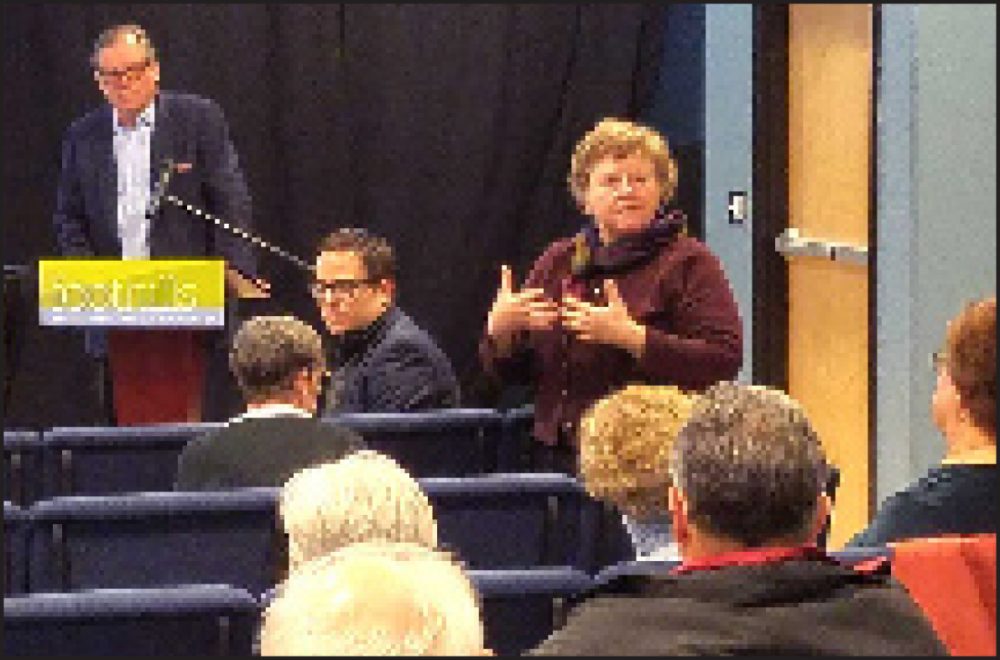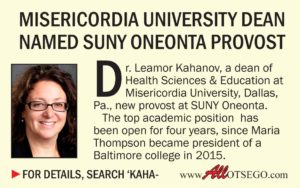For $3M, Theater
Can Reopen In
Collaboration With Foothills
By JENNIFER HILL

ONEONTA – Oneonta Theater can be back in business again for $3 million.
Evan Delli Paoli, an architect with the New York City-based firm, Holzman Moss Botino, told a gathered audience at Foothills on Tuesday, Feb. 19 that amount would pay for basic but necessary restorations and improvements needed to make Oneonta Theater operational.
That was the final conclusion in the feasibility study, headed by Duncan Webb, Webb Management Services, into whether or not the Oneonta Theatre could be saved.
Delli Paoli labeled that combination of cost and restoration items as a “Good” budget item as well as two other budget-restoration packages labeled “Better” and “Best.” Their budgets were $6 million and $10 million, respectively, with more restoration items and higher quality work corresponding to the costs.
“All three of these price points are so the project can move forward,” Delli Paoli said.
Basic work on the theater included such items as stabilizing the theater’s interiors and overall structure and bringing the building into code compliance. The higher cost packages added items such as restoration of the theater’s interior plaster and enlarging the orchestra pit.
Delli Paoli also presented a list of “a la carte” restoration/improvement items that he said could be done independently or in addition to one of the three suggested budget categories.
He also proposed $2-300,000 for doing minor improvements to the Foothills Theater. He said his firm envisioned the Oneonta Theater and Foothills established as anchors of a new arts district in Oneonta.
Duncan Webb, whose firm specializes in making theaters an economically viable and vibrant part of communities, followed Delli Paoli’s report, giving an optimistic business analysis of the Oneonta Theater if it re-opens.
Showing detailed projected budgets over five years after a restored Oneonta Theater opens, he predicted the venue would be financially stable within one year and be able to cover 80 percent of its operating expenses by the fifth year. Fundraising would pay for the remaining 20 percent of operating expenses, which would amount to an average of $300,000 a year.
Funds could be raised through grants and foundational endowments as well as individual contributions, he said.
It was unclear how much Webb’s predictions of Oneonta Theater’s future success rely on Foothills partnering with the theater after it is restored. Foothills’ Board has not indicated yet if it wants the partnership.
“We sprung this idea of a partnership on Foothills,” Webb said. “It is unfair to expect that Foothills will say ‘yes’ today.”
He also acknowledged that SUNY Oneonta was not ready to partner its theater with a future Oneonta Theater either because of recent changes in leadership. The college has just hired a new provost, for example.
But Webb added, “Oneonta Theater really shouldn’t proceed independently.”
Patrice Maculuso, president of the Friends of Oneonta Theatre and a driving force behind the restoration of the theatre, said, “I think we made progress already by having this conversation.”
She added, “For me, these theatres are all about building your communities where your various communities can intersect and encounter each…and find ways to interact, particularly in polarizing times.”

